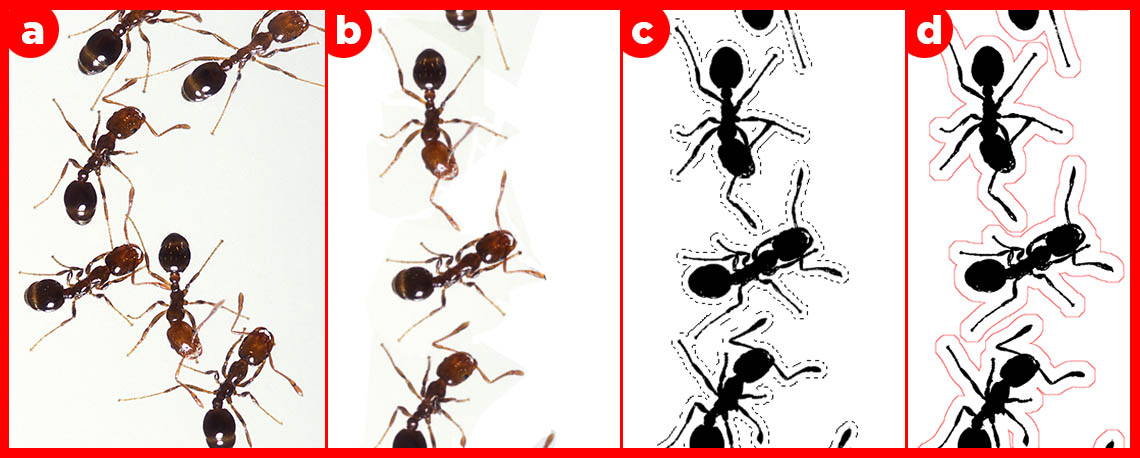Ants as Living Legos
FIRE ANTS (Solenopsis species) can link together to form bridges across gaps and make living rafts to navigate through water. Interestingly, weaver ants and army ants also exhibit these behaviors. I decided to make a lasercut pressfit kit to interact with and better understand this fascinating aspect of ant social life.

To get started, I located a clear, mostly-overhead photo of fire ants on Wikipedia (a). Using Photoshop, I separated and reconstructed individuals (b), thresholded the images, and used the select>modify>expand command to create larger selections around them (c). [Sidenote: amusingly, these animated dotted-line selections are sometimes called marching ants.] Then I stroked these selections with a hairline red pen (d) and imported the bitmap into CorelDraw for laser cutting.

My first test was to create smallish ants, probably 3-4 times life-size. This way I could check to ensure my settings weren't too ridiculous; trying the spiral model for development as promoted by Neil. Once this worked, and I made a nice bridge between two spots in the shop (without slots at this point- just 'cheating' by mashing the cardboard together), I did some test cuts that showed me that 0.14 inches was a nice software-defined slot setting (given the thickness of my cardboard and the laser's kerf- 'collateral damage' burned away during cutting). Then I doubled the size of the ants, and inserted chamfered notches using a custom-defined CorelDraw symbol. This had the advantage that I could easily replicate and edit the notch pattern. I couldn't subtract the notches from the outer cut of the ants without converting from a symbol to a specific shape (that then wouldn't be linked to the master symbol), so I just kept the independent symbols superimposed.

I defined red to signify cuts through the cardboard (high power, low speed) and black to trigger raster 'printing' (faster speed and fewer pulses per inch). In the end, after creating ten ants, I made a bifurcating bridge where ants were attached foot-to-foot... Real ants do the same thing using little claws called tarsi.
Finally, my ants got to climb a real tree and successfully bridged across two branches. Good job, gals! (Nearly all ants you see are female; males generally only exist briefly and have wings.) Given time, I would like to add notches on the mandibles so the ants could carry to-scale lasercut food items such as seeds, eggs, caterpillars, ticks, spiders, and scorpions. There could even be scale ant queens or reproductive males. The kit could also be made three-dimensional, so that individual ants are composed of 4-5 intermeshed pieces of cardboard corresponding to labelled major body divisions.
Thanks to Daniel Rosenberg for his help throughout the process! I am also indebted to Alex Wild, whose 'ants as living legos' phrase I've borrowed. Curious about ant bridges? Here is a nice article in Quanta Magazine.